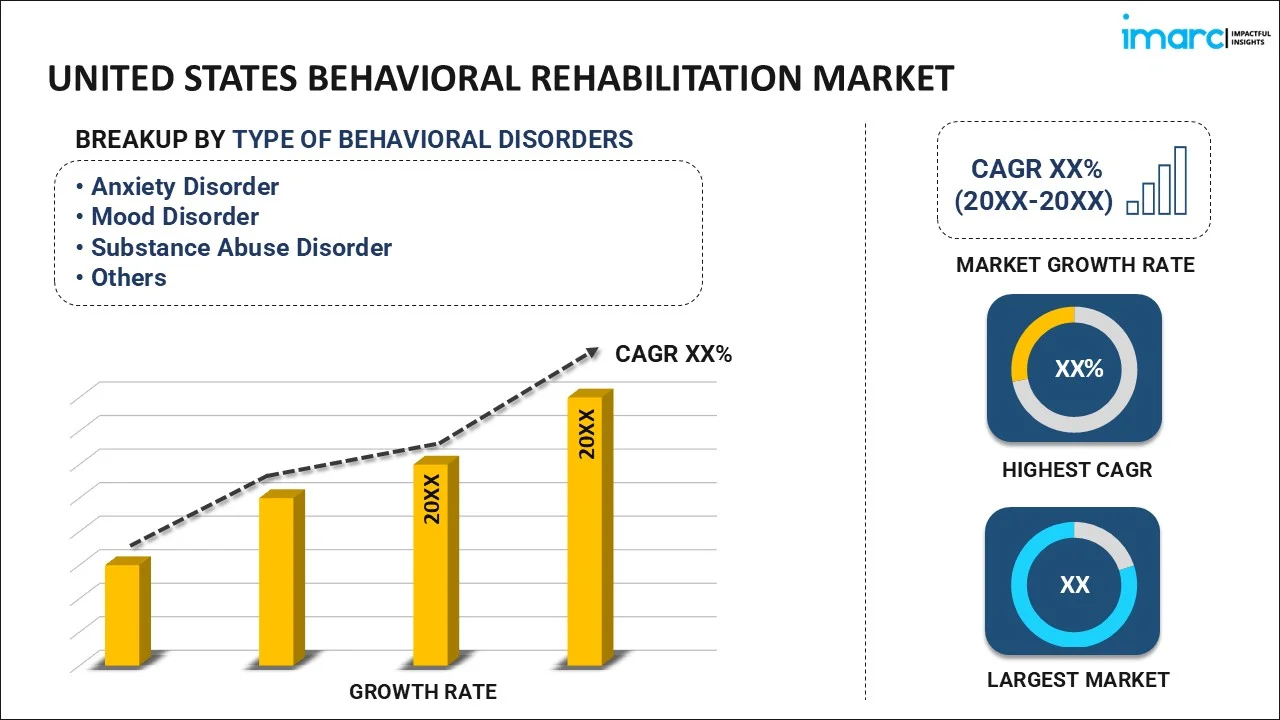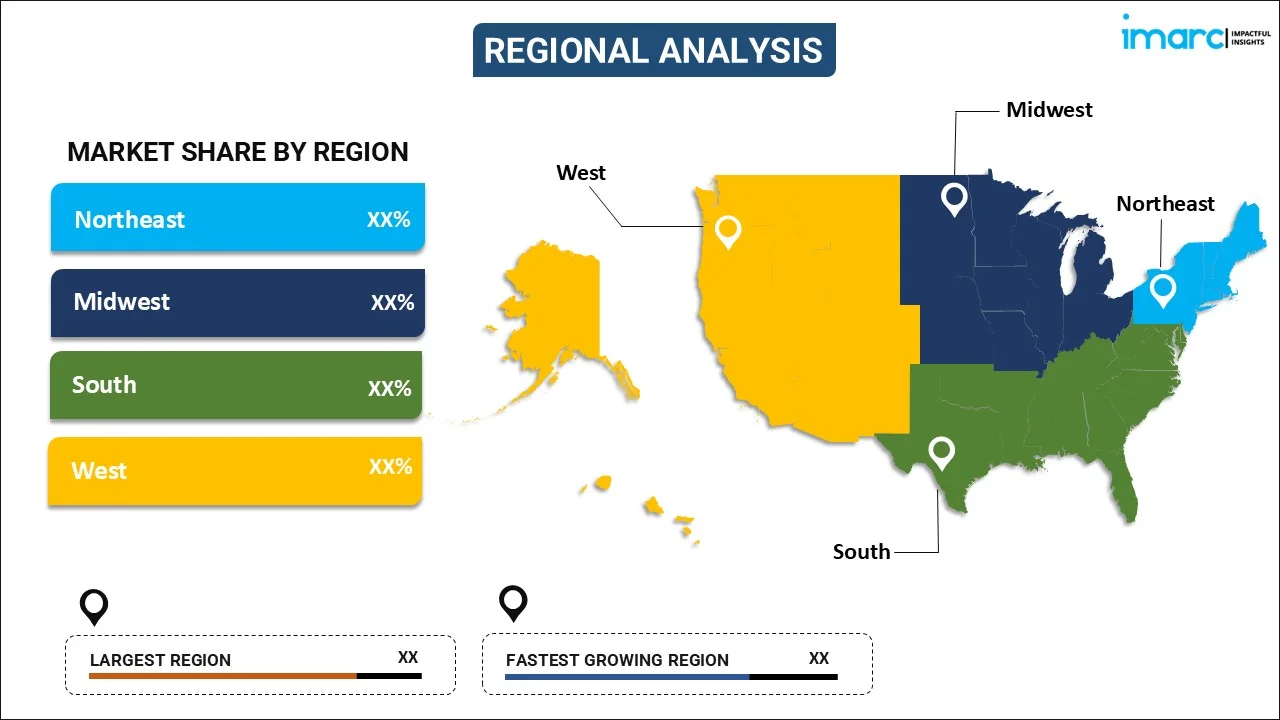
United States Behavioral Rehabilitation Market Report by Type of Behavioral Disorder (Anxiety Disorder, Mood Disorder, Substance Abuse Disorder, Personality Disorder, Attention Deficit Disorder), Healthcare Setting (Outpatient, Inpatient, Residential), Treatment Method (Counselling, Medication, Support Services, and Others), and Region 2025-2033
United States Behavioral Rehabilitation Market Overview:
The United States behavioral rehabilitation market size reached USD 65.5 Billion in 2024. Looking forward, IMARC Group expects the market to reach USD 96.9 Billion by 2033, exhibiting a growth rate (CAGR) of 4% during 2025-2033. The market is witnessing robust expansion, majorly driven by escalating demand for personalized treatment and mental health awareness. Moreover, advancements in the therapeutic sector and proliferating healthcare policies are further spurring United States behavioral rehabilitation market share, creating significant opportunities for stakeholders and providers.
|
Report Attribute
|
Key Statistics
|
|---|---|
|
Base Year
|
2024 |
|
Forecast Years
|
2025-2033
|
|
Historical Years
|
2019-2024
|
| Market Size in 2024 | USD 65.5 Billion |
| Market Forecast in 2033 | USD 96.9 Billion |
| Market Growth Rate (2025-2033) | 4% |
United States Behavioral Rehabilitation Market Analysis:
- Key Growth Drivers: The United States behavioral rehabilitation market is propelled by growing incidence of mental illnesses, growing abuse cases, and rising awareness of behavioral therapies. Expanded insurance coverage and government programs favoring treatment of mental illnesses improve access to services. Increased demand for customized, evidence-based models of care also fuels United States behavioral rehabilitation market growth.
- Key Market Trends: Integration of digital health platforms such as telepsychiatry and mobile applications, adoption of integrative therapies, and focus on outpatient treatment models are the key trends. Value-based care and collaborations between rehabilitation centers and payers are emerging. Remote monitoring technologies and AI-based treatment personalization are influencing the future direction of care.
- Market Opportunities: Opportunities include growing telehealth solutions, AI-based predictive behavioral analysis, and expanded uptake of community programs. Growing societal interest in work-place mental health offers potential for employer collaboration. Investment in integrated care facilities that provide mental and physical care together has potential for long-term growth and better patient outcomes.
- Market Challenges: The United States behavioral rehabilitation market analysis reports that the challenges include stigma attached to treatment of behavioral health, lack of trained professionals, and unequal access among rural and underserved populations. Complications from regulations and reimbursement constraints hamper adoption of new therapies. Expensive treatment costs, relapse rates of patients, and challenges in long-term persistence present hindrances to long-term rehabilitation success across the country.
United States Behavioral Rehabilitation Market Trends:
Rising Adoption of Telehealth Services
The United States behavioral rehabilitation market is witnessing a significant inclination towards the use of telehealth services. This trend is mainly driven by improvements in digital health technologies and patients’ desire for efficient and accessible care services. Telehealth services allow for remote consultations, virtual therapy sessions, and constant check-ups, making behavioral health services a more accessible solution, especially for rural areas where conventional services are scarce. In addition, the growth of telehealth is supported by regulatory modifications that promote reimbursement for online services, leading to increased adoption rates. Consequently, several rehabilitation centers are seeking to enhance the telehealth structures to meet the increasing need and enhance their services. According to a research article published by the National Institute of Mental Health in June 2024, 80% of health treatment facilities in the U.S. offer telehealth services. Of these, 77% provide medication management, 97% offer counseling services, and 96% provide diagnostic services.
Increasing Focus on Personalized Treatment Methods
The United States of America’s behavioral rehabilitation market has shifted from a standardized approach to a more tailored approach with an escalated emphasis on the development of individualized treatment plans. This is largely attributed to improved understanding of the various needs of patients with behavioral health problems, along with enhanced data analysis and technologies used in monitoring patients. Furthermore, personalized treatment programs are integrating various forms of therapy, including cognitive behavioral therapy (CBT), pharmacotherapy, and complementary and integrative practices like meditation and physical activities, to attract a broader range of clients. According to a research article published by National Institutes of Health in May 2023, CBT is a highly effective treatment solution for personality disorders, depression, schizophrenia, bipolar disorder, etc. Furthermore, this focus on personalization aims to enhance treatment outcomes by tailoring interventions to the specific requirement and conditions of each patient.
Incorporation of Behavioral Health into Primary Care
The incorporation of behavioral health services into primary care settings is becoming more prevalent in the United States. This trend is principally fueled by the recognition that mental health is an essential component of overall health, and that early intervention can significantly improve outcomes. According to the National Institute of Mental Health, mental disorders are highly prevalent in the United States, affecting tens of millions of people annually. Moreover, as per industry reports, 3.7 million adults in the U.S. are currently living with schizophrenia spectrum disorders. Primary care providers are increasingly integrating behavioral health screenings, consultations, and treatments into their practice, generally facilitated by collaboration with behavioral health specialists. Moreover, this integrated care system not only improved patient access to extensive care but also lowers the stigma associated with seeking mental health treatment, contributing to better patient outcomes and elevated demand for behavioral rehabilitation services.
United States Behavioral Rehabilitation Market News:
- In February 2024, Caron Treatment Centers, one of the leading behavioral healthcare providers in the U.S., expanded its Neurorestorative Health Care services by launching a revolutionary Neurocognitive Assessment Program for patients struggling with mental health disorders like behavioral issues, cognitive decline, trauma, anxiety, decision-making, depression, etc.
- In August 2024, North Dakota Health and Human Services (HHS) announced a strategic partnership with Hazelden Betty Ford Foundation, one of the leading behavioral rehabilitation providers in the U.S. As per the partnership terms, both facilities will offer training to address addiction, mental, and behavioral disorders.
United States Behavioral Rehabilitation Market Segmentation:
IMARC Group provides an analysis of the key trends in each segment of the market, along with forecasts at the country level for 2025-2033. Our report has categorized the market based on type of behavioral disorder, healthcare setting, and treatment method.
Type of Behavioral Disorder Insights:

To get more information on this market, Request Sample
- Anxiety Disorder
- Mood Disorder
- Substance Abuse Disorder
- Personality Disorder
- Attention Deficit Disorder
The report has provided a detailed breakup and analysis of the market based on the type of behavioral disorder. This includes anxiety disorder, mood disorder, substance abuse disorder, personality disorder, and attention deficit disorder.
Healthcare Setting Insights:
- Outpatient
- Inpatient
- Residential
A detailed breakup and analysis of the market based on the healthcare setting have also been provided in the report. This includes outpatient, inpatient, and residential.
Treatment Method Insights:
- Counselling
- Medication
- Support Services
- Others
The report has provided a detailed breakup and analysis of the market based on the treatment method. This includes counselling, medication, support services, and others.
Regional Insights:

- Northeast
- Midwest
- South
- West
The report has also provided a comprehensive analysis of all the major regional markets, which include Northeast, Midwest, South, and West.
Competitive Landscape:
The market research report has also provided a comprehensive analysis of the competitive landscape. Competitive analysis such as market structure, key player positioning, top winning strategies, competitive dashboard, and company evaluation quadrant has been covered in the report. Also, detailed profiles of all major companies have been provided.
Latest News and Developments:
- In July 2025, Iowa launched its redesigned Behavioral Health and Disability Services Systems, ensuring equal access statewide to mental health, substance use, problem gambling, and disability support. The Behavioral Health Service System, supported by the Iowa Primary Care Association, streamlines care while “Your Life Iowa” offers 24/7 support. Disability Access Points, within the ADRC Network, now coordinate disability services. Governor Reynolds and HHS Director Garcia highlighted the system’s person-centered approach to improve care access and outcomes.
- In January 2025, Governor JB Pritzker announced the launch of BEACON (Behavioral Health Care and Ongoing Navigation), a new portal providing Illinois families with centralized access to children’s behavioral health services. Developed by the Children’s Behavioral Health Transformation Initiative, BEACON connects parents to community resources, state-funded programs, and care coordination tools. Officials emphasized breaking stigma, improving accessibility, and fostering collaboration across agencies to strengthen youth mental health support and empower families statewide.
United States Behavioral Rehabilitation Market Report Coverage:
| Report Features | Details |
|---|---|
| Base Year of the Analysis | 2024 |
| Historical Period | 2019-2024 |
| Forecast Period | 2025-2033 |
| Units | Billion USD |
| Scope of the Report | Exploration of Historical Trends and Market Outlook, Industry Catalysts and Challenges, Segment-Wise Historical and Future Market Assessment:
|
| Type of Behavioral Disorders Covered | Anxiety Disorder, Mood Disorder, Substance Abuse Disorder, Personality Disorder, Attention Deficit Disorder |
| Healthcare Settings Covered | Outpatient, Inpatient, Residential |
| Treatment Methods Covered | Counselling, Medication, Support Services, Others |
| Regions Covered | Northeast, Midwest, South, West |
| Customization Scope | 10% Free Customization |
| Post-Sale Analyst Support | 10-12 Weeks |
| Delivery Format | PDF and Excel through Email (We can also provide the editable version of the report in PPT/Word format on special request) |
Key Benefits for Stakeholders:
- IMARC’s industry report offers a comprehensive quantitative analysis of various market segments, historical and current market trends, market forecasts, and dynamics of the United States behavioral rehabilitation market from 2019-2033.
- The research report provides the latest information on the market drivers, challenges, and opportunities in the United States behavioral rehabilitation market.
- Porter's five forces analysis assist stakeholders in assessing the impact of new entrants, competitive rivalry, supplier power, buyer power, and the threat of substitution. It helps stakeholders to analyze the level of competition within the United States behavioral rehabilitation industry and its attractiveness.
- Competitive landscape allows stakeholders to understand their competitive environment and provides an insight into the current positions of key players in the market.
Key Questions Answered in This Report
The behavioral rehabilitation market in the United States was valued at USD 65.5 Billion in 2024.
The United States behavioral rehabilitation market is projected to exhibit a CAGR of 4% during 2025-2033, reaching a value of USD 96.9 Billion by 2033.
The United States behavioral rehabilitation market is driven by rising cases of mental health disorders, substance abuse, and stress-related conditions. Increasing awareness about treatment options, government initiatives to improve behavioral healthcare infrastructure, and growing acceptance of therapy and rehabilitation programs are further supporting market demand and expansion.
Need more help?
- Speak to our experienced analysts for insights on the current market scenarios.
- Include additional segments and countries to customize the report as per your requirement.
- Gain an unparalleled competitive advantage in your domain by understanding how to utilize the report and positively impacting your operations and revenue.
- For further assistance, please connect with our analysts.
 Request Customization
Request Customization
 Speak to an Analyst
Speak to an Analyst
 Request Brochure
Request Brochure
 Inquire Before Buying
Inquire Before Buying




.webp)




.webp)












